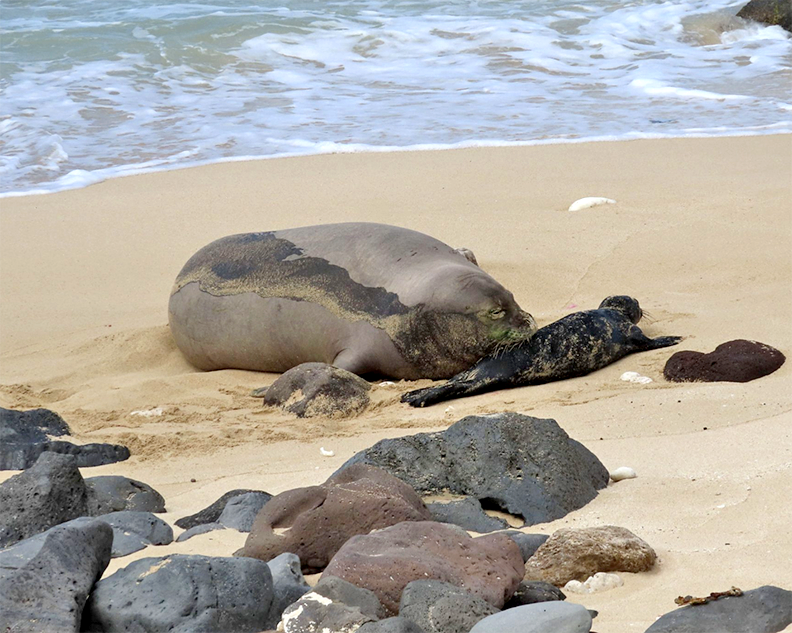By Léo Azambuja

Kapaʻa Sunshine Market. Courtesy of kauaigrown.org
You are what you eat. So eat local, and you’ll see how fast you’ll become a local. True dat, really.
And I don’t mean eating Kahlua pig, chicken lau lau, lomi lomi salmon, opihi, poi, saimin, raw fish and da kine dis and dat (though I encourage eating all of it). I mean eating locally grown produce, locally caught seafood and locally raised livestock.
But before you eat local food, you’ve got to buy it somewhere, right? That is, assuming you don’t grow your own food. So, for the average citizen, buying local food means, most of the time, going to farmers’ markets. This alone has a practical effect in stamping a local label on you. In no time, you’ll see yourself defending and promoting all things local.
Even if you were born elsewhere, and you’re occasionally called a haole, a foreigner in Hawaiian, shopping through local farmers’ markets will in many ways instill in you a sense of belonging to this island.
Here’s the breakdown.

Kauaʻi Community College Sunshine Market. Courtesy of kauaigrown.org
If you go to the Sunshine Market in Kapa‘a, you park your car a block or two from the market, because it’s crowded, very crowded. Then you get a darn good workout by walking — more like hiking — from your car to the market. Just like old Hawaiians used to hike to grow, gather or barter food. Yes, you’re walking through asphalt, pot holes, then grass, mud, puddles, more pot holes, more puddles. It’s no hiking trail, but it sure feels like one.
Let’s face it, it’s fun to buy at a farmers’ market. You shop around for cheaper produce, and then you try to negotiate a cheaper price. It’s almost like buying stocks, with the difference that you won’t go poor or rich, and you can actually eat what you buy. Got that? You’re eating a product of the very land you live. It’s the island nursing you with real food.

Waipaʻa Sunshine Market. Courtesy of kauaigrown.org
You meet quite a few farmers on a personal level, many of them coming from generations of farm workers. In no time, you’re calling them aunties and uncles. It’s like shopping from your ‘ohana, your family.
Then, of course, you weave through an eclectic crowd of rich and poor, yoga goddesses, surfers, hippies, musicians, stay-at-home moms, lawyers, police officers, anyone and everyone. Later, you see them in town, and they see you. You catch yourself saying, “Howzit?” to all kinds of people.
You spend your money on local vendors, who in turn spend back the dollars (I feel I should coin this term, pun intended) at your business or workplace.
And the best and worst of all, you endure a hell of a traffic jam in Kapa‘a during a time of the day you swore you’d never drive through there again. But hey, if you don’t experience at least once a week the worst Kapa‘a has to offer, how can you call yourself local?

Kapaʻa Sunshine Market. Courtesy of kauaigrown.org
If you can go through Kapa‘a traffic without exploding in frustration, or worse, road rage, you deserve to be called a local. And it’s a problem that dates back a half century, so it’s likely going nowhere despite best efforts from local officials. You’re simply experiencing the living history by enduring Kapa‘a traffic.
All that just by eating local.
At the end of the day, you will feel you belong here. You put your money where your mouth is. Besides, supermarkets seem boring after you experience a Sunshine Market in all its glory. True dat.
On a side note, I attended the 2016 Food Justice Summit at Kaua‘i Community College last month. Four women from four different backgrounds all shared stories of empowering communities to protect their agricultural rights.
As one of the speakers wisely put, food sovereignty goes beyond the right to food; it’s the right to land and food production. This message fits right here on Kaua‘i.
People like Sol Kahn, Adam Asquith, the Wooton family, Jerry Ornellas, Ned Whitlock and many unsung heroes are proving there are many different and successful ways to run an agricultural business, small, medium or large.
 There might not be enough farmers on Kaua‘i to feed the whole island, but the number of small farms is growing since the demise of sugar plantations.
There might not be enough farmers on Kaua‘i to feed the whole island, but the number of small farms is growing since the demise of sugar plantations.
Before stepping out of the stage at the Performing Arts Center at KCC, Sarojeni Rengam, executive director of the Pesticide Action Network in Asia and the Pacific and a steering committee member for the Asian Rural Women’s Coalition, said, “Together we can do it, and the people, united, will never be defeated.”
Go to a farmers’ market, especially Wednesday in Kapa‘a, and you’ll notice the growing number of people who are unsuspectingly proving Rengam’s words just by increasing demand for local produce.
True dat, again.

Discover more from ForKauaiOnline
Subscribe to get the latest posts sent to your email.




Leave a Reply